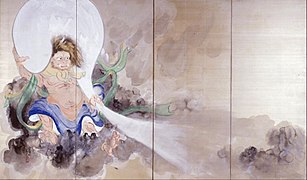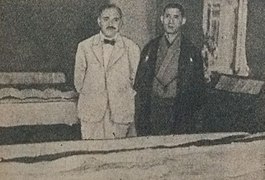Tomita Keisen
Tomita Keisen ( Japanese 冨 田 溪 仙 ; born December 9, 1879 in Hakata , Fukuoka Prefecture ; died July 6, 1936 ) was a Japanese painter of the Nihonga direction during the Meiji , Taishō, and early Shōwa periods .
life and work
Tomita Keisen began his training as a painter under the court painter of the Kuroda , Kinugasa Morimasa (衣 笠 守 正; 1852-1912), who taught him in the style of the Kanō school . In 1896 Tomita went to Kyōto and trained further under Tsuji Kakō (都 路 華 香; 1870-1931), a painter of the Maruyama Shijō school . While studying under Tsuji, he was at the exhibitions of the Nihon Kaiga Kyōkai (日本 絵 画 協会), the Shin-Kobijutsuhin-ten (新 古 美術品 展), the Goankyōkai (後 案 協会) and other exhibitions.
That was the time when he was looking for a basis for life in which he became interested in Christianity, Zen, studied the Buddhist images of the Heian period in Nara , traveled to China and stayed in Okinawa. At the 6th Bunter exhibition in 1912 he showed the picture "Kormoran-Boats" (鵜 船, Usen), which Yokoyama Taikan found good. Taikan invited him in 1915 to exhibit at the exhibition of Nihon Bijutsuin , "Inten" for short, in Tōkyō, whereupon he exhibited the picture "Teitōge Jōnin" (鼎 峠 上人), with which he was named a friend of Bijutsuin. In terms of style, however, he remained tied to the direction that was not so strictly programmatic in Kyōto, although he also took up Nanga influences. This was shown at the 6th Inten exhibition in 1918, where he showed the pair of screens "Windgott - Donnergott" (風神 雷神, Fūji - Raijin). The pair of adjustable screens “Yodo” (淀), which is loosely designed and depicts the landscape on the Yodo River with the wheel of a water mill, also dates back to that time .
In the Taishō period, Tomita increasingly occupied himself with depicting well-known landscapes. He created the series “Eight Views of Saga” (嵯峨 八景, Saga Hakkei) based on “Eight Views of ...”, a classic cycle of images on a landscape. In 1923 Tomita was introduced to Paul Claudel through the French ambassador through the mediation of the Romanist Yamanouchi Yoshio (山 内 義 雄; 1894–1972) , with whom he then published illustrated collections of poetry.
In 1931 Tomita was in Berlin at the exhibition of Japanese painting . In 1935 he became a member of the Academy of Arts . - Tomita was active until the end of her life. The late works from the thirties include "Omuro cherry trees" (御 室 桜; 1933), "carrier pigeons" (伝 書 鳩, Densho-bato) from 1934 and a revised version of "Man'yō Shunshū" (万 葉春秋) 1936 .
photos
literature
- National Museum of Modern Art, Kyoto (Ed.): Tomita Keisen. In: Kyōto no Nihonga 1910–1930. National Museum of Modern Art, Kyoto, 1986. ISBN 4-87642-117-X .
- Laurance P. Roberts: Tomita Keisen . In: A Dictionary of Japanese Artists. Weatherhill, 1976. ISBN 0-8348-0113-2 .
Web links
Individual evidence
- ↑ "Bunten" (文 展) is the abbreviation for Mombushō bijutsu tenrankai ( 文部省 美術展 覧 会 ), ie for the annual state art exhibition of the Ministry of Culture between 1907 and 1918. From 1919 it was abbreviated to “Teiten” ( 帝 展 ) for ( 帝国美術展 覧 会 , Teikoku bijutsu-in tenrankai ).
- ↑ “Omuro cherry trees are famous for their flowers. You can see them at the Ninna-ji in Kyōto. "
| personal data | |
|---|---|
| SURNAME | Tomita, Keisen |
| ALTERNATIVE NAMES | 冨 田 溪 仙 (Japanese); Tomita Shigegorō (real name); 冨 田 鎮 五郎 (real name, Japanese) |
| BRIEF DESCRIPTION | Japanese painter |
| DATE OF BIRTH | December 9, 1879 |
| PLACE OF BIRTH | Hakata , Fukuoka Prefecture |
| DATE OF DEATH | July 6, 1936 |





